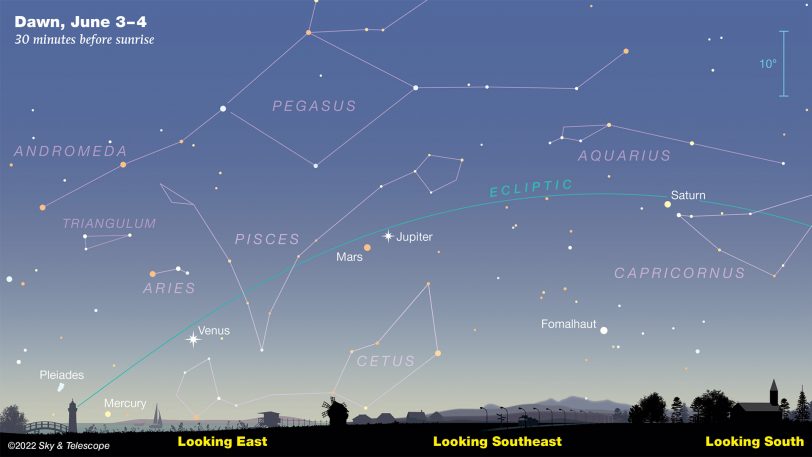Starting June 3, all five naked-eye planets will be up in the pre-dawn sky.
This month, skywatchers will be treated to a rare “planet parade”: all five naked-eye worlds will align in their proper orbital order from the sun in our sky.
Mercury, Venus, Mars, Jupiter, and Saturn can all be seen in a row from left to right in the southeastern predawn sky. (Mercury will be close to the horizon when the show begins on June 3, but will become more visible as the month progresses.)
According to Sky&Telescope, the five-planet party will take up 91 degrees of our sky on June 3. “Find a place with a clear view low toward the east to maximize your chances of catching Mercury,” the magazine said in a press release.
You’ll also need to move quickly. “You’ll have less than half an hour between when Mercury first appears above the horizon, and when it essentially gets lost in the glare of the rising sun,” Sky&Telescope wrote.
Because the planets all travel on the plane of the solar system known as the ecliptic, they will shine in a row like that. However, they will not be as close as they appear; each of these worlds is millions of miles away from the others. Still, the show is not to be missed; the last time we saw these five planets in this configuration was in 2004, according to Sky&Telescope.
The best chance to see the spectacle may be on June 24. According to the magazine, Mercury should rise about an hour before the sun. Even better, the crescent moon will pass between Venus and Mars, “serving as a proxy Earth.”

However, the planets will be further apart, with a maximum range of 107 degrees between Mercury and Saturn. (Your clenched fist held at arm’s length covers about 10 degrees of sky.)
That said, if you’re clouded out or unavailable on these dates, all five worlds should be visible through much of June.
Conjunctions involving fewer worlds are very common in Earth’s sky, and we want to make sure you’re ready for the next opportunity when that happens.
Conjunctions involving fewer worlds are common in the Earth’s sky, and we want to make sure you’re ready for the next time one occurs.
If you want to see planets in the night sky, check out our guide to the best telescope deals right now. If you need equipment, check out our best astrophotography lenses to get ready for the next planet sighting.
READ MORE: The New NASA’s IXPE Space Telescope Shares Its First, Historic Glimpse of The Cosmos






Thank you